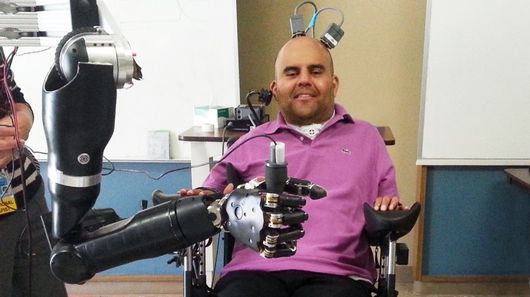
Although we've definitely seen a number of thought-controlled prosthetic arms before, most of those have been activated by implants in the user's motor cortex, which is the brain's movement-control center. The arms' resulting movements have been somewhat jerky, plus there's typically been a delay between the user thinking about moving the arm, and the actual movement taking place. Now, however, a team of researchers has announced the results of an experiment in which those limitations were greatly reduced.
In 2013, members of the team – composed of scientists from Caltech, USC's Keck School of Medicine, and Rancho Los Amigos National Rehabilitation Center – implanted a pair of 4x4-mm electrode arrays in the posterior parietal cortex (PPC) of quadriplegic Erik G. Sorto. Unlike the motor cortex, which controls movement directly, the PPC is responsible for the intent to move.
The arrays were placed in two parts of Sorto's PPC, one of which controls the intent to reach with the arm, and the other of which is responsible for grasp. Each of those arrays contain 96 electrodes, which in turn monitor the activity of a single neuron. Cables run from skull portals connected to the two arrays, to a computer system that decodes the neural activity into movement commands. The computer then proceeds to relay those commands to the robotic arm.
After a period of training, Sorto is now able to use the arm for tasks such shaking hands, drinking beverages, and even playing rock-paper-scissors – plus its movements are relatively smooth and instantaneous. He can also use the interface to control the movement of a cursor on a computer screen.
"It gives me great pleasure to be part of the solution for improving paralyzed patients’ lives," says Sorto. "I joke around with the guys that I want to be able to drink my own beer – to be able to take a drink at my own pace, when I want to take a sip out of my beer and to not have to ask somebody to give it to me. I really miss that independence. I think that if it were safe enough, I would really enjoy grooming myself – shaving, brushing my own teeth. That would be fantastic."

 Previous page
Previous page Back to top
Back to top







